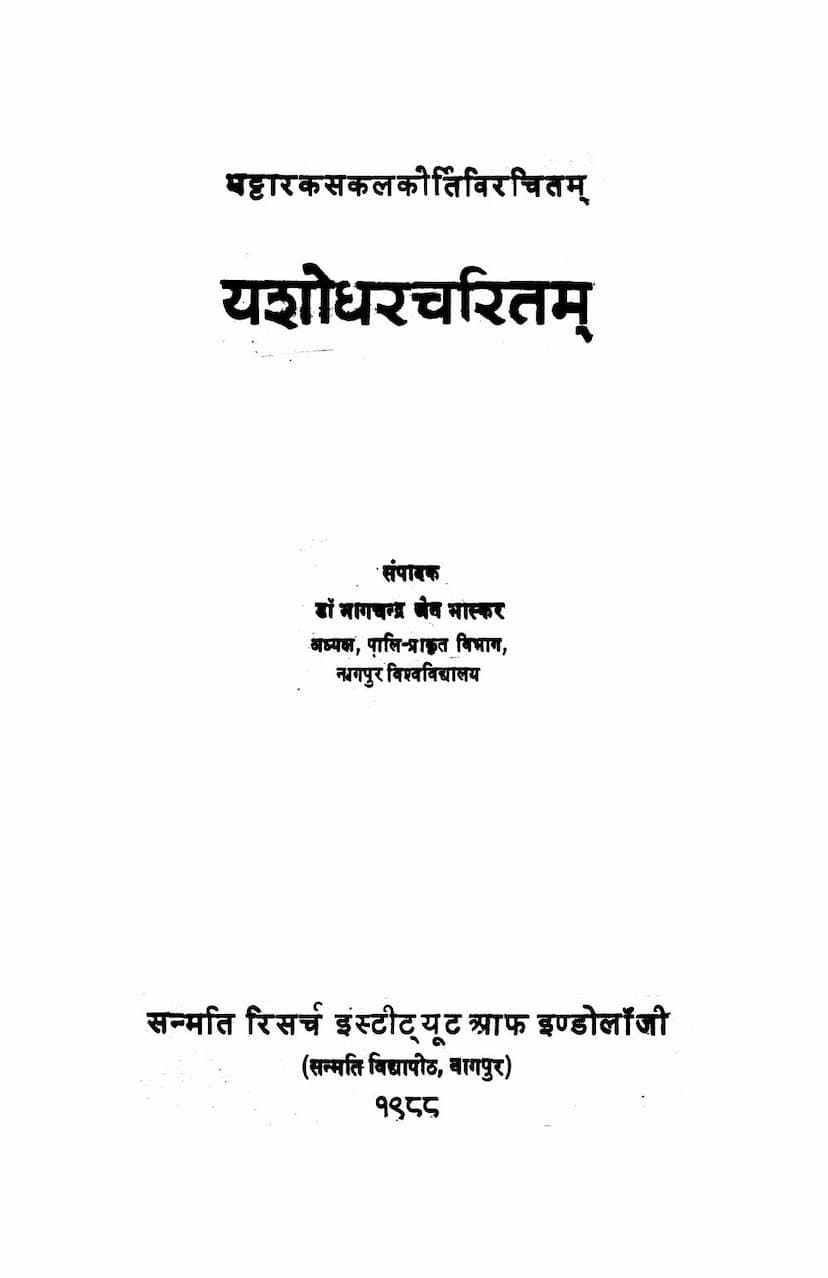Yashodhar Charitam
Added to library: September 2, 2025

Summary
Here's a comprehensive summary of the Jain text "Yashodhar Charitam" by Bhagchandra Jain, based on the provided information:
Book Title: Yashodhar Charitam Author: Bhattāraka Sakalakīrti Publisher: Sanmati Research Institute of Indology, Nagpur Year of Publication: 1988
Overall Purpose and Theme:
The Yashodhar Charitam is a significant Dharmakathā (religious narrative) within Jain literature. It primarily illustrates the severe and painful consequences of immoral actions and the detrimental results of violence in spiritual pursuits. The narrative strongly emphasizes the paramount importance of karma (actions and their consequences) and ahimsā (non-violence) in achieving liberation. The story demonstrates how even actions performed with good intentions, if rooted in violence or unethical practices, can lead to immense suffering across multiple lifetimes.
Narrative Structure and Key Story Elements:
The story is a complex tapestry of transmigration and the unfolding of karma, spanning eight previous births before the present narrative's climax. It begins and ends with a conversation between King Maridatta and the kṣullaka-yugala (pair of junior ascetics) Abhayaruci and Abhayamati.
Synopsis of the Story:
-
The Present Context (King Maridatta's Sacrifice): The story opens with King Maridatta of Rājapur in Yaudheya, who is performing the worship of the deity Candamāri. To gain a "conquering sword," he intends to offer pairs of various creatures to the goddess. During this time, two newly ordained Jain monks, Abhayaruci and Abhayamati (brother and sister), are apprehended for sacrifice while on their alms round. King Maridatta, upon learning their identity, expresses compassion. Abhayaruci then reveals their past lives, explaining the cyclical suffering caused by his own past actions and criticizing the violent approach to worship. He recounts his previous birth where he sacrificed a flour-cock, leading to his current predicament.
-
The Cycle of Eight Births (Yashodhara's Past Lives): The core of the narrative details the eight births:
- Birth 1: King Yashodhara of Ujjain: Yashodhara, at the behest of his mother Candramati, sacrifices a flour-cock to a deity. His wife Amṛtamati is involved with Mahadatta. Later, Amṛtamati poisons Yashodhara and Candramati.
- Birth 2: Dog and Peacock: Yashodhara is reborn as a dog, and Candramati as a peacock in the same palace. The peacock witnesses Amṛtamati's affair and attempts to harm Mahadatta's eyes.
- Birth 3: Serpent and Mongoose: The peacock is reborn as a mongoose and Yashodhara as a serpent.
- Birth 4: Crocodile and Milter (Fish): They are reborn as a crocodile and a fish.
- Birth 5: She-goat and her Son: They become a she-goat and her son.
- Birth 6: Buffalo and He-goat: Further down the cycle, they are reborn as a buffalo and a he-goat.
- Birth 7: Two Cocks: In their seventh rebirth, they are born as two cocks.
- Repentance and the Next Birth: One day, the two cocks encounter the Jain sage Sudatta. Through the sage's teachings, they perceive their past births and cry out in repentance.
- Birth 8: Abhayaruci and Abhayamati: They are then killed by Prince Yashomati (son of Yashodhara) and are reborn as his son, Abhayaruci, and daughter, Abhayamati.
-
The Path to Renunciation: Prince Yashomati, along with his children Abhayaruci and Abhayamati, visits the sage Sudattacārya. Sudattacārya reveals their ancestral lineage and past lives through his divine knowledge. Upon learning the truth of their suffering caused by past actions, Yashomati, Abhayaruci, and Abhayamati all renounce worldly life and embrace Jain ordination.
-
The Resolution: King Maridatta, moved by the teachings and the story, also becomes a Jain monk. His son orders that no living beings should be killed henceforth.
Key Teachings and Messages:
- Karma and Transmigration: The story powerfully illustrates the Jain concept of karma, showing how actions, even seemingly minor ones like sacrificing a flour-cock, have far-reaching consequences across countless lifetimes. The cycle of births and deaths (samsara) is depicted as a source of immense suffering due to unexpiated karma.
- Ahimsa (Non-violence): The narrative strongly advocates for non-violence, contrasting the suffering caused by violent acts (like animal sacrifice and murder) with the peace and ultimate liberation achieved through adherence to ahimsa.
- Critique of Ritualistic Violence: The story critiques the practice of sacrificing animals in religious rituals, highlighting that such acts are considered misguided and lead to negative karmic repercussions.
- The Importance of Renunciation and Jain Principles: The characters' eventual renunciation of worldly life and acceptance of Jain monasticism underscores the Jain path to liberation from suffering.
- The Power of Knowledge and Repentance: Encountering the sage Sudatta awakens the cocks to their past actions, leading to repentance and setting them on the path of spiritual progress.
- Ethical Conduct: The narrative also touches upon the consequences of lust, attachment, betrayal, and the importance of righteous conduct.
Author and Historical Context:
Bhattāraka Sakalakīrti, the author, was a prominent Jain scholar and poet who lived in the 15th century (born around 1386 AD). He was a prolific writer in Sanskrit, Prakrit, and Rajasthani Hindi, composing numerous works on Jain philosophy, history, and literature. The Yashodhar Charitam is considered one of his notable Mahākāvyas (grand poems). The text itself has a rich literary history, with various versions and retellings by other Jain Acharyas like Haribhadrasūri, Somadeva, and Pushpadanta.
Manuscript and Editing:
The edition of the Yashodhar Charitam presented here was edited by Dr. Bhagchandra Jain Bhaskar and is based on four manuscripts, with one from the Lūnakaraṇa temple in Jaipur being particularly significant due to its 16th-century paintings. The publication received financial assistance from the Ministry of Human Resource Development, Department of Education, Government of India.
Literary Significance:
The Yashodhar Charitam is a vital work in Jain literature for its ability to convey profound philosophical and ethical principles through an engaging and extensive narrative. Its exploration of karma and the consequences of violence serves as a powerful moral lesson for adherents of Jainism. The inclusion of detailed descriptions of the rebirths and the suffering endured makes the message particularly impactful.